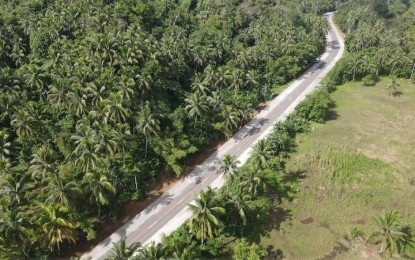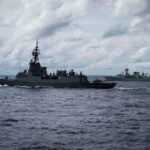TACLOBAN CITY – More funds have been allocated for the repair of damaged sections of the Pan-Philippine Highway in Eastern Visayas, including the bumpy roads in Samar province, following the directive of President Ferdinand R. Marcos Jr., the Department of Public Works and Highways (DPWH) announced.
Records indicate that approximately PHP6.59 billion has been allocated under the 2025 General Appropriations Act for the rehabilitation of damaged sections of the major road, also known as the Maharlika Highway, stretching from Northern Samar to Southern Leyte.
This marks the second consecutive year of increased funding for the region’s major highway. In 2024, the 395.52-km segment of the Maharlika Highway in Eastern Visayas received PHP8.05 billion.
A significant portion of the budget is designated for Samar province, where many sections require urgent rehabilitation, according to DPWH Eastern Visayas officials.
“The entire Maharlika Highway, including its component bridges from Luzon to Mindanao, is slated for rehabilitation through foreign funding. However, we cannot wait for that process. Since last year, we have included the repair of the Maharlika Highway in our regular budget,” officials stated.
Of this year’s total allocation, PHP3.6 billion is earmarked for Samar province (80 projects), PHP1.14 billion for Leyte (18 projects), PHP808 million for Southern Leyte (16 projects), PHP758 million for Northern Samar (7 projects), and PHP292 million for the portion of the highway in Tacloban City (4 projects).
The 2025 allocation will fund 125 projects, including road reconstruction, road and bridge widening, slope protection, off-carriageway improvements, drainage systems, and the installation of road signs and pavement markings.
Most projects are concentrated in Samar province, where recent assessments revealed that out of the 205 km of the highway in two legislative districts, about 77 km received a bad rating, while 39 km were rated poor.
Officials noted that sections with poor ratings require complete reconstruction.
During a visit to Calbayog City, Samar, in July 2024, President Marcos pledged immediate repairs for damaged sections of the primary highway in Samar province through increased funding.
The DPWH previously stated that fully rehabilitating the road stretch from Northern Samar to Southern Leyte would require PHP29.75 billion, including the PHP8.05 billion allocated in 2024 and the PHP6.59 billion set aside this year.
Pan-Philippine Highway
The **Pan-Philippine Highway**, also known as **Maharlika Highway**, is the longest highway in the Philippines, spanning approximately **3,517 kilometers (2,185 miles)** from Luzon to Mindanao. Completed in the **1970s** with support from international aid, it was designed to improve transportation and economic connectivity across the archipelago. The highway passes through diverse landscapes, linking major cities, rural areas, and key cultural sites, though some sections remain under development due to challenging terrain.
Maharlika Highway
The Maharlika Highway is the longest highway in the Philippines, stretching approximately 3,379 kilometers from Luzon to Mindanao. Originally developed during the American colonial period and later expanded under President Ferdinand Marcos in the 1960s-70s, it serves as a vital transportation route connecting major regions across the country. The highway was renamed in 2017 from “Pan-Philippine Highway” to “Maharlika,” a term linked to pre-colonial Filipino nobility, though this change remains controversial due to its historical associations.
Calbayog City
Calbayog City, located in the province of Samar, Philippines, is a historic urban center known for its rich cultural heritage and natural attractions. Established as a parish in 1785 and later as a city in 1948, it played a significant role in the region’s Spanish colonial history and the Philippine resistance movement. Today, it is recognized for its waterfalls, caves, and vibrant festivals, blending history with ecotourism.
Northern Samar
Northern Samar, a province in the Eastern Visayas region of the Philippines, is known for its rugged landscapes, caves, and pristine beaches. Historically, it was a significant site during the Spanish colonial period and played a role in World War II as a landing point for U.S. forces. Today, it remains a culturally rich area, home to indigenous communities and vibrant local traditions.
Samar province
Samar Province, located in the Eastern Visayas region of the Philippines, is known for its lush forests, rugged landscapes, and rich cultural heritage. Historically, it played a significant role during the Spanish colonial period and was a key site during World War II. Today, it is celebrated for its natural attractions, including the Sohoton Caves and natural bridges, as well as vibrant local traditions.
Southern Leyte
Southern Leyte is a province in the Philippines known for its stunning natural landscapes, including pristine beaches, diving spots, and the iconic Limasawa Island, where the first Catholic Mass in the country was held in 1521. The region played a significant role in Philippine history as part of the historic landing site of Ferdinand Magellan, marking the introduction of Christianity. Today, Southern Leyte is also recognized for its marine biodiversity, particularly around Sogod Bay, a popular destination for whale shark encounters.
Tacloban City
Tacloban City, located in the Eastern Visayas region of the Philippines, is the capital of Leyte province and a historically significant city. It is best known as the site of General Douglas MacArthur’s famous return during World War II in 1944, fulfilling his promise to liberate the Philippines. The city also suffered devastating damage from Typhoon Haiyan (Yolanda) in 2013 but has since rebuilt and remains an important cultural and economic hub in the region.
Eastern Visayas
Eastern Visayas is a region in the Philippines comprising three main islands: Samar, Leyte, and Biliran. It is historically significant as the site of the first recorded Catholic mass in the Philippines (1521) and the landing of General Douglas MacArthur in 1944, marking the beginning of the liberation from Japanese occupation. The region is known for its natural attractions, including the San Juanico Bridge and the Sohoton Caves, as well as vibrant cultural festivals like the Pintados-Kasadyaan.






